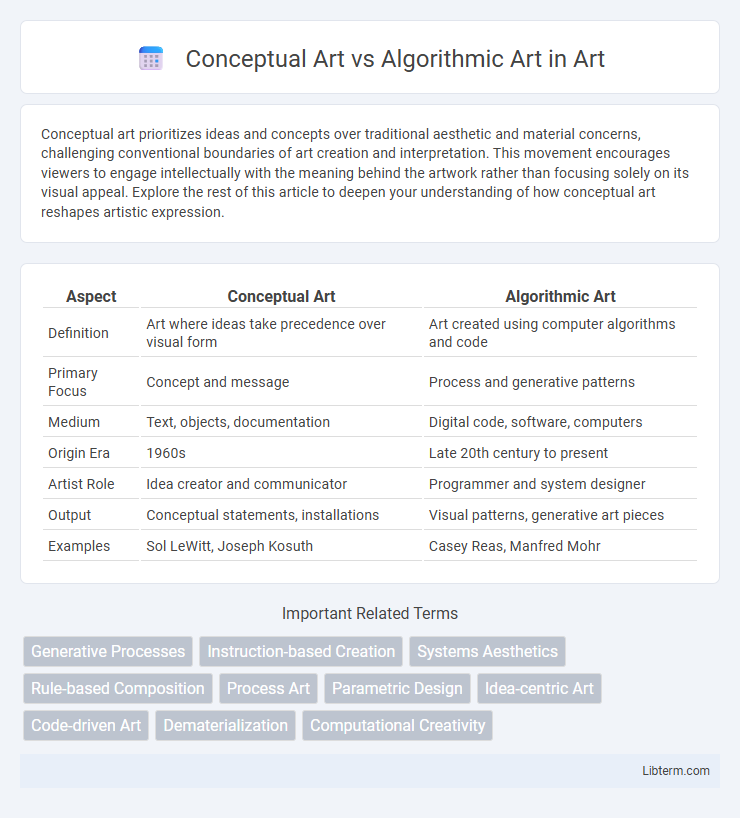Conceptual art prioritizes ideas and concepts over traditional aesthetic and material concerns, challenging conventional boundaries of art creation and interpretation. This movement encourages viewers to engage intellectually with the meaning behind the artwork rather than focusing solely on its visual appeal. Explore the rest of this article to deepen your understanding of how conceptual art reshapes artistic expression.
Table of Comparison
| Aspect | Conceptual Art | Algorithmic Art |
|---|---|---|
| Definition | Art where ideas take precedence over visual form | Art created using computer algorithms and code |
| Primary Focus | Concept and message | Process and generative patterns |
| Medium | Text, objects, documentation | Digital code, software, computers |
| Origin Era | 1960s | Late 20th century to present |
| Artist Role | Idea creator and communicator | Programmer and system designer |
| Output | Conceptual statements, installations | Visual patterns, generative art pieces |
| Examples | Sol LeWitt, Joseph Kosuth | Casey Reas, Manfred Mohr |
Defining Conceptual Art: Ideas Over Aesthetics
Conceptual art prioritizes ideas and concepts over traditional aesthetic and material concerns, emphasizing intellectual engagement rather than visual appeal. It emerged in the 1960s as a movement where the artistic process and message overshadowed the physical artwork, challenging conventional definitions of art. Unlike algorithmic art, which uses code and computational processes to generate visuals, conceptual art centers on conveying abstract thoughts and philosophical inquiries.
What Is Algorithmic Art? Code as Creative Medium
Algorithmic art is a form of digital art generated through mathematical algorithms and computer code, where the artist writes instructions to create visual compositions. This creative process transforms programming languages like Python, JavaScript, or Processing into tools for artistic expression, bridging technology with aesthetics. By using code as a creative medium, algorithmic art explores patterns, randomness, and generative systems to produce dynamic, evolving visuals that challenge traditional art boundaries.
Historical Origins: From Duchamp to Digital
Conceptual Art emerged in the 1960s, pioneered by Marcel Duchamp's readymades challenging traditional art by prioritizing ideas over aesthetics. Algorithmic Art originated later with the advent of computer technology in the 1960s and 1970s, utilizing mathematical formulas and code to generate visual forms. Duchamp's influence bridges both movements by shifting focus to intellectual engagement, paving the way for digital algorithms as contemporary creative tools.
Key Principles: Conceptual Intention vs. Computational Execution
Conceptual Art emphasizes the primacy of the artist's idea or intention, where the concept is the core of the artwork and the physical form is secondary or even irrelevant. Algorithmic Art relies on computational execution, using mathematical algorithms and code to generate visual patterns and structures, often creating works that evolve dynamically or autonomously. The key principle in Conceptual Art is the intellectual engagement with meaning and idea, whereas Algorithmic Art prioritizes procedural generation and systematic exploration of form through software.
Notable Artists and Influential Works
Conceptual Art features notable artists like Sol LeWitt and Joseph Kosuth, whose works emphasize ideas over visual forms, such as LeWitt's "Wall Drawings" and Kosuth's "One and Three Chairs." Algorithmic Art includes pioneers like Vera Molnar and Harold Cohen, known for integrating computer algorithms to create art, exemplified by Molnar's geometric compositions and Cohen's AARON software-generated paintings. Both movements challenged traditional artistic boundaries and continue to influence contemporary digital and conceptual practices.
The Creative Process: Human Thought vs. Machine Logic
Conceptual Art centers on human thought, emphasizing ideas and mental engagement as the core of creativity, allowing artists to express abstract concepts through intentional symbolism and narrative. Algorithmic Art relies on machine logic, utilizing computational formulas and code to generate patterns and visuals based on predefined algorithms, which can produce complex, often unexpected results. The creative process in Conceptual Art is introspective and subjective, while in Algorithmic Art, it is systematic and driven by mathematical precision.
Viewer Interpretation: Meaning, Interaction, and Engagement
Conceptual Art prioritizes the viewer's interpretation by emphasizing ideas and symbolic meaning over visual form, encouraging active intellectual engagement and personal reflection on abstract concepts. Algorithmic Art involves viewer interaction through generative processes, where the artwork evolves based on computational parameters, inviting users to influence or witness dynamic visual outcomes. Both forms challenge traditional passive viewing, fostering deeper engagement by integrating meaning and interaction into the artistic experience.
Technology’s Role: Tools, Techniques, and Limitations
Conceptual Art emphasizes ideology and process over material, often using minimal technology such as photography or text to convey intangible ideas, whereas Algorithmic Art harnesses computer algorithms and programming, relying heavily on digital tools like coding languages, data sets, and generative software to create intricate patterns and dynamic visuals. The limitations of Conceptual Art lie in the physical constraints and subjective interpretation of materials, while Algorithmic Art faces challenges in computational power, algorithmic bias, and software capabilities. Technology in Algorithmic Art enables unprecedented complexity and interactivity, contrasting with Conceptual Art's focus on human cognition and conceptual frameworks.
Contemporary Relevance: Shaping Modern Art Worlds
Conceptual Art emphasizes ideas over aesthetic form, influencing contemporary art by challenging traditional definitions and encouraging intellectual engagement. Algorithmic Art harnesses computational processes and code as creative tools, reflecting the digital era's impact on artistic production and expanding possibilities for innovation. Both movements shape modern art worlds by redefining authorship, incorporating technology, and provoking critical dialogue on creativity and meaning.
The Future of Art: Bridging Conceptual and Algorithmic Practices
Conceptual art emphasizes ideas and meaning over traditional aesthetics, while algorithmic art uses computational processes to generate visual forms. The future of art lies in integrating conceptual frameworks with algorithmic techniques, enabling artists to explore complex narratives and interactive experiences through code-driven creativity. This fusion offers new possibilities for personalized, dynamic artworks that respond to viewer engagement and evolving data inputs.
Conceptual Art Infographic

 libterm.com
libterm.com